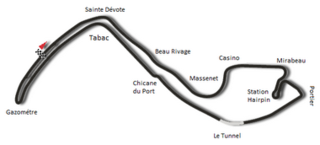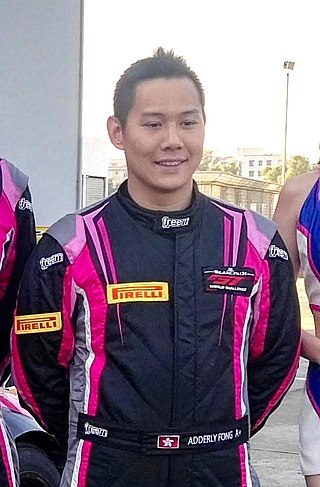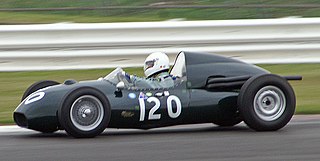Related Research Articles

John Michael Hawthorn was a British racing driver. He became the United Kingdom's first Formula One World Champion driver in 1958, whereupon he announced his retirement, having been profoundly affected by the death of his teammate and friend Peter Collins two months earlier in the 1958 German Grand Prix. He died in a road accident three months after retiring.

The British Grand Prix is a Grand Prix motor racing event organised in the United Kingdom by Motorsport UK. First held by the Royal Automobile Club (RAC) in 1926, the British Grand Prix has been held annually since 1948 and has been a round of the FIA Formula One World Championship every year since 1950. In 1952, following the transfer of the lease of the Silverstone Circuit to the British Racing Drivers' Club, the RAC delegated the organisation of races held at Silverstone to the BRDC, and those held at Aintree to the British Automobile Racing Club. This arrangement lasted until the RAC created the Motor Sports Association in the late 1970s and it reclaimed organising control of the event. The RAC MSA was renamed Motorsport UK in 2019 when it formally split from the RAC.
The Surtees Racing Organisation was a race team that spent nine seasons as a constructor in Formula One, Formula 2, and Formula 5000.

Brands Hatch is a motor racing circuit in West Kingsdown, Kent, England, United Kingdom. Originally used as a grasstrack motorcycle circuit on farmland, it hosted 12 runnings of the British Grand Prix between 1964 and 1986 and currently hosts many British and International racing events. The venue is owned and operated by Jonathan Palmer's MotorSport Vision organisation.

The 1967 Monaco Grand Prix was a Formula One motor race held at Monaco on May 7, 1967. It was race 2 of 11 in both the 1967 World Championship of Drivers and the 1967 International Cup for Formula One Manufacturers, albeit four months after Pedro Rodríguez's unexpected victory at Kyalami. The 100-lap race was won by Brabham driver Denny Hulme after he started from fourth position. Graham Hill finished second for the Lotus team and Ferrari driver Chris Amon came in third.

Jonathan Charles Palmer is a British businessman and former Formula One racing driver. Before opting for a career in motor racing, Palmer trained as a physician at London's Guy's Hospital. He also worked as a junior physician at Cuckfield and Brighton hospitals.

Michael Simon Brindley Bream Beuttler was a British Formula One driver who raced privately entered March cars. He was born in Cairo, Egypt, the son of Colonel Leslie Brindley Bream Beuttler, Duke of Wellington's Regiment, O.B.E., and a descendant on his mother's side of the Scottish ornithologist William Robert Ogilvie-Grant, grandson of the 6th Earl of Seafield.

Peter John Collins was a British racing driver. He was killed in the 1958 German Grand Prix, just weeks after winning the RAC British Grand Prix. He started his career as a 17-year-old in 1949, impressing in Formula 3 races, finishing third in the 1951 Autosport National Formula 3 Championship.

Roy Francesco Salvadori was a British racing driver and team manager. He was born in Dovercourt, Essex, to parents of Italian descent. He graduated to Formula One by 1952 and competed regularly until 1962 for a succession of teams including Cooper, Vanwall, BRM, Aston Martin and Connaught. Also a competitor in other formulae, he won the 1959 24 Hours of Le Mans in an Aston Martin with co-driver Carroll Shelby.

Emilio de Villota Ruíz is a former racing driver from Spain, born in Madrid. He entered 15 Formula One World Championship Grands Prix between 1976 and 1982, qualifying twice. He entered most Spanish Grand Prix between 1976 and 1982 and became a major force in the short-lived Aurora AFX Formula One Championship for F1 cars, winning the title in 1980.

JBW Cars was a British racing car manufacturer in the late 1950s, who were a Formula One constructor from 1959 to 1961.

Peter John Arundell was a British racing driver from England, who raced in Formula One for Team Lotus. He participated in 13 World Championship Grands Prix, scoring 12 championship points.

Rial is a German producer of light alloy wheels and rims, and was a Formula One constructor competing in the 1988 and 1989 seasons. Founded in the 1970s as a wheel rim producer, the company was bought by Günter Schmid, ex-owner of the ATS wheels company in 1987. Schmid followed the same strategy as he had at ATS, advertising the Rial wheel brand by entering Formula One as a constructor. Rial participated in 32 Grands Prix, entering a total of 48 cars. They scored six championship points, finishing a highest of ninth in the constructors championship in 1988. After leaving Formula One at the end of the 1989 season, the Rial Racing division was closed, and the company did not race again. Rial continues to manufacture wheels and rims from its factory in Fußgönheim.
Spirit Racing was a racing car constructor and racing team from the United Kingdom. Founded in 1981, it participated in the 1982 European Formula Two Championship, moved to Formula One in 1983, then competing in the 1988 F3000 season before finally folding at the end of that year. In 26 F1 races, its best finish was seventh at the 1983 Dutch Grand Prix.
Rob Walker Racing Team was a privateer team in Formula One during the 1950s and 1960s. Founded by Johnnie Walker heir Rob Walker (1917–2002) in 1953, the team became F1's most successful privateer in history, being the first and only entrant to win a World Championship Formula One Grand Prix without ever building their own car.
Brian Roger Hart was a British racing driver and engineer with a background in the aviation industry. He is best known as the founder of Brian Hart Limited, a company that developed and built engines for motorsport use.
Eric Harrison Broadley MBE was a British entrepreneur, engineer, and founder and chief designer of Lola Cars, the motor racing manufacturer and engineering company. He was arguably one of the most influential automobile designers of the post-war period, and over the years Lola was involved with many high-profile projects in Formula One, Indy car, and sports car racing. Broadley sold Lola to Martin Birrane in 1997.

Adderly Fong Cheun-yue is a Canadian-Hong Kong racing driver. His career started in 2004. He is currently competing in the Blancpain GT World Challenge Asia racing series. He also completed the 2014 24 Hours of Le Mans with OAK Racing Team Asia, finishing 11th overall and 7th in the LMP2 class. In 2015, he was appointed as a test driver at Lotus F1 Team.

The Williams FW04 was a Formula One car used by Frank Williams Racing Cars during the 1975 season and Wolf–Williams Racing during the 1976 season. The car was a development of the Williams FW and two were built. Although not a particularly successful car, an FW04 finished second at the 1975 German Grand Prix.

The JBW-Maserati, also known as the JBW Type 1, is a race car, designed, developed, and built by British manufacturer and constructor, JBW, in 1958. It raced in both open-wheel and closed-wheel guises. It competed in both Formula Libre events, as well as 4 Formula One World Championship Grand Prix races, between 1959 and 1961; debuting at the 1959 British Grand Prix, but scored no points over that period of time. It was initially powered by a naturally-aspirated 2.5 L (150 cu in) Maserati 4-cylinder engine four-cylinder engine, which droves the rear wheels through a 5-speed manual transmission. It scored no World Championship points during its time in Formula One racing.
References
- 1 2 3 "Encyclopedia - Fry". Grandprix.com. Inside F1. Retrieved 4 November 2011.
- ↑ "Encyclopedia - Mike Parkes". Grandprix.com. Inside F1. Retrieved 3 November 2011.
- 1 2 "Fry F1 History". ChicaneF1.com. Retrieved 5 November 2011.